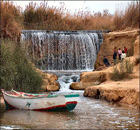|
Site of the Crocodilopolis where the crocodile-headed god Sobek was worshipped, Fayoum is the largest of the desert oasis. It is easily accessible, and offers several sites of historical interest. Nearby are huge, relatively unpolluted freshwater lakes, including Boheiret Qarun.
|
|
|
 The Temple of Sobek The Temple of Sobek |
| |

The Temple of Sobek, or the Narmuthis Temple is located in Fayoum and built by Amenemhet III. The temple was dedicated to the gods Sobek, Emutet and Horus. It is guarded by sphinxes and lions and the interior walls are covered with hieroglyphics and reliefs of Amenemhet III and Amenemhet IV.
|
|
 Temple of Stones Temple of Stones |
| |
The Temple of Stones, or the Temple of Dionysias was a Roman fort built in the 3rd century BC for the god Sobek. Unique for the temples of Fayoum, this temple still has its roof. In the interior are fourteen rooms on either side of a central corridor that leads to three chapels. Thermal baths decorated with frescoes and glassworks were uncovered in 1948, but are once again covered by the sand.
|
|
 Pyramid of Hawara Pyramid of Hawara |
| |
The Pyramid of Hawara was built by Amenemhet III and at the time was the most visited sites of the ancient World. Herodotus claimed to have counted three thousand rooms in the pyramids funeral complex.
|
|
 Pyramid of Maidum Pyramid of Maidum
|
| |
The pyramid of Maidum was originally a seven-stepped pyramid, which was later enlarged to an eight-stepped pyramid. After some time the steps were filled in and a smooth outer facing turned it into a true pyramid. It stands on the desert's edge and is the only structure in the vicinity.
It is a huge structure that is surrounded by the debris from the casing that collapsed. It is believed that Huni, the last ruler of the 3rd Dynasty started the Maidum pyramid and that it was completed by his son, Sneferu who as the first King of the 4th Dynasty. The pyramid is 144 meters square and 42 meters high. The entrance is on the north side and consists of a 30-meter stairway. A passageway descends 57 meters downwards into the pyramid's foundation. The walls are lined in limestone. The construction timbers are still visible in this room. Near the pyramid is a cemetery, which contains some important and quite large mastabas. A little north of the Maidum Pyramid is the remains of the Seila step pyramid. It is made of limestone and is thought to be from the 2nd Dynasty. |
|
|
